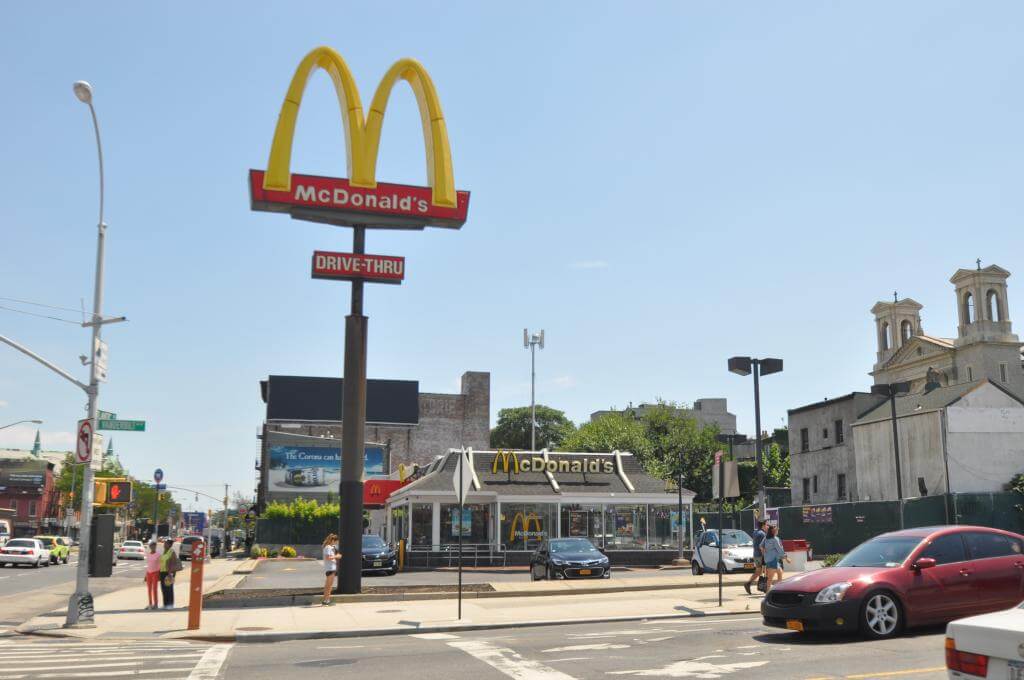Locals Object to Density of Proposed Apartment Building Near Barclays in Prospect Heights
Prospect Heights community board members pushed back against a developer’s plans to construct an 18-story, 316-unit apartment complex.

Rendering via City Planning Commission
Prospect Heights community board members pushed back against a developer’s plans to construct a residential building housing 316 apartments — some of which would be income restricted — because, they claim, the neighborhood is “swimming in density.”
“There is no reason to add density to a neighborhood like Prospect Heights that is absolutely swimming in density,” said Elaine Weinstein during a March 4 meeting of Community Board 8’s land use committee. “We cannot walk on our streets anymore. The amount of traffic, garbage, is uncontrollable, and therefore it seems unrealistic to build this building as large, as high, as dense as you are proposing.”
The lot at 840 Atlantic Avenue at the corner of Vanderbilt Avenue currently features a drive-through McDonald’s, but developer Vanderbilt Atlantic Holdings wants a rezoning to allow them to build their proposed 18-story apartment building — which provoked outrage from board members because of its height and potential to increase the neighborhood’s population.
Contrary to the locals’ claims of abnormal density in the neighborhood, however, Prospect Heights features around 83.6 people per acre of land, making it just 67.5 percent as dense as neighboring Crown Heights, and comparably dense to nearby Park Slope.
In fact, much of the density that does exist in the area comes from the Pacific Park megadevelopment, an in-progress multi-tower mixed-use project that includes Barclays Center and several towers near the heavily commercial Atlantic Center. The rest of the neighborhood is mainly low-scale brownstones and walk-up apartment buildings.

Representatives for Vanderbilt Atlantic Holdings argued that the positioning of the lot — situated at the corner of a four-lane road and a six-lane road, just two blocks from Barclays Center — actually makes it the perfect location to absorb a high-density development.
“If there’s anywhere in the neighborhood that density belongs, it’s right here,” said land-use attorney Benjamin Stark.
The chair of Community Board 8 acknowledged that much of the area could stand to increase in vertical size, but countered that, just because the site can handle a large density project, doesn’t mean it should.
“You’ve got the two wide streets, and you have an abutting neighborhood that’s still relatively low-density and livable,” said Ethel Tyus. “So just because you can build higher and denser because you have these two wide streets converging, doesn’t mean you should.”
Community board members took issue with the project not conforming to the desired density of developments within the M-Crown zone, an in-the-works rezoning that seeks to allow for residential development in the industrial corridors of Crown Heights and Prospect Heights while preserving jobs and community spaces.
The M-Crown framework as currently laid out would allow at most a 14-story building on the McDonalds lot. Stark argued that since it lies in the M-Crown area that allows for the most density, a taller building should be considered, especially given its location along two extra-wide avenues.
“I do think it’s perhaps disingenuous to say that this site isn’t deserving of a density beyond that of the balance of the M-Crown area,” Stark said. “It has unique conditions that make it, from a land-use perspective, the most appropriate location for the most density.”
If built, the developer would be required to earmark a percentage of the building’s units as “affordable” under the city’s Mandatory Inclusionary Housing program. They said they intend to go with Option No. 2, which requires 30 percent of units on average to be aimed at families making 80 percent of Area Median Income, which works out to $81,920 for a family of three. No more than three income bands can be included, and no income band can exceed 130 percent of AMI, or $133,120 for a family of three.
The board tabled the vote on the proposal for its April land-use meeting, but encouraged the developer to scale their plan down.
“It’s really just too tall and too dense,” said Tyus.
Whenever the volunteer board votes, the proposal would head to the borough president’s office for another non-binding opinion, before heading to the City Planning Commission and the City Council for final approval.
Editor’s note: A version of this story originally ran in Brooklyn Paper. Click here to see the original story.
Related Stories
- Temporary Restraining Order Halts Public Review Process at Spice Factory Site in Crown Heights
- Apartment Tower With Affordable Housing Could Replace Jitterbug-Era Bank in Brighton Beach
- Locals Push Back Over Red Hook Rezoning That Seeks to Bypass Public Review
Sign up for amNY’s COVID-19 newsletter to stay up to date on the latest coronavirus news throughout New York City. Email tips@brownstoner.com with further comments, questions or tips. Follow Brownstoner on Twitter and Instagram, and like us on Facebook.





What's Your Take? Leave a Comment